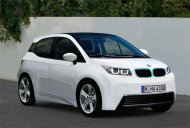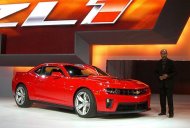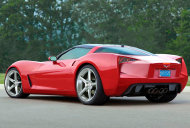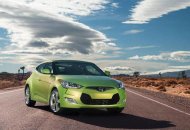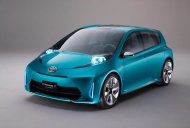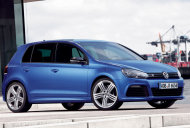It's a distinctly American trait to want what's next — even before it's here. Yes, Americans are spoiled, with too many choices in every genre of product, especially cars. But so what? This is the place where cars blossomed, where the first (and arguably best) car culture still exists. And where we haven't stopped loving — and lusting after — the cool car around the next bend. With that in mind, here's PM's 10 cool cars under $50,000 that will go on sale in the next 18 months. Note that the exact dates may not be 100 percent accurate: The timetable is based on what the notoriously vague car flacks told us. So we've pried free what info we could, and we share it with you here.
BMW i3 Electric City Car (Early 2013)
BMW
claims that its new $35,000 Chevy Volt-beater will have 99 miles of range from its rear-mounted electric motor and floor-mounted batteries. BMW (being BMW) is also claiming 100 mph for the car's top speed, and the i3 could bring the equivalent of 150 horsepower. Cargo will be divided between the rear seats and in the front trunk (a la the original, rear-engine VW Beetle). Much of the body will be made of carbon-reinforced plastic.
Wireless charging is one intriguing concepts we hope makes it to market. In conjunction with industrial giant Siemens, BMW is working on a magnetic field charging system, like those used in wireless laptop and cell phone charging pads, where a car would parked above a charging station. At that point, a coil in both the ground and the vehicle would recognize each other and begin the charge. This beats having your Volt or Prius PHV plugged in via wire at a garage or mall for a few hours, where vandalism or other hazards exist.
Chevrolet Camaro ZL1 (January 2012)
A hot Camaro is coming and will be powered by the Cadillac CTS-V's 6.2-liter V8 with roughly 550 hp. Given how the Camaro SS with a 6.2-liter V8 that puts out a mere 426 hp can already clock a 0-to-60-mph sprint in less than 5 seconds, the ZL1 is going to be scary fast. This Camaro will go toe-to-toe with Ford's Shelby GT500—and BMW M3 and Porsche 911 owners should watch their rearviews too. Price? We'd guess between $42,000 and $48,000.
Chevrolet Corvette C7 (Late 2012)
The current 'Vette has looked the same for nearly 13 years. Though it's still an amazing car, delivering Ferrari-like performance for one-fifth the price, it's dated in many respects. Expect a lot from the all-new C7 Corvette, then, with cool exterior cues like a split rear window and a vastly upgraded interior that's well above the coach-class quarters of the present car. But handling, which has always been the car's strongest suit, will remain largely unaltered. Horsepower targets in the 400-450 range would be a safe bet for this $50,000 car, even as GM aims to lower displacement to shave weight and nudge up the fuel economy. There might even be forced induction of some kind, and it's perfectly reasonable to expect direct fuel injection for the newest crown jewel of the Chevy badge.
Ford Fiesta ST (Fall 2012)
The Fiesta ST will have an altered body for improved cooling, but may be available only as a three-door hatch. It will have better suspension tuning, possibly Recaro racing seats, some unique trim, 17-inch wheels, speed-rated performance tires and dual exhaust. Ford reportedly experimented with cramming the 2.0-liter engine from the Focus ST into this car. Unfortunately, that won't be coming to the showroom, partly because Ford is working hard to differentiate its two hot hatches. The automaker is launching them at least six months apart and trying to give the Fiesta as much of a sport focus as possible, while selling the Focus with more of an upscale feel. So expect the Fiesta to carry a directly injected, turbocharged 1.6-liter four.
We don't know the Fiesta ST's price yet, but one would think it couldn't go much higher than $23,000, with rivals like the Nissan Sentra SE-R coming in at $20,000 and the Civic Si smack at $23,000.
Hyundai Veloster (November 2011)
Hyundai is pulling a very neat trick with its Veloster. It's a slightly larger car inside than the Scion tC (and Mini Clubman or Honda CR-Z hybrid). Yet thanks to a very low 2,600-pound curb weight — 400 pounds less than the tC — it's said to get up to 40 mpg from its directly injected, 1.6-liter four-cylinder engine. That would best Honda's CR-Z numbers without necessity of hybrid technology, and with the benefit of a bigger cabin. One oddity: Access to the interior is a bit quirky, with one door on the driver's side, but both front and rear doors on the passenger side. Remember that weight? Fewer doors allow a carmaker to reduce structural reinforcements, and that keeps down bulk. And a low weight allows an increase in fun factor — indeed, Hyundai is promising greater sportiness than its rivals. Can the Veloster "out-fun" a Mini? Hmm, we're not sure, but Hyundai is promising a tighter turning circle than even a base Mini Cooper and a sophisticated, buttoned-down-sounding suspension. Transmissions include Hyundai's first dual-clutch six speed (hopefully with paddles) or a six-speed manual. Pricing should be in the $20,000 range.
Mini Paceman (April 2012)
The Paceman is a two-door concept coupe that debuted last year, and our sources say it's a lock for production. Mini will have to work hard with this model, though, which is essentially the forthcoming Countryman minus two doors. The Paceman should either get real horsepower and ride considerably lower than the Countryman (think: a big version of the Mini Cooper S, but with all-wheel drive), or be made even more all-road capable than the Countryman, as a rival to the likes of the Subaru WRX — of course in full rally-car livery. The latter may actually be more likely, as Mini is racing a 2011 Countryman in the World Rally Championships. That car? It gets 300 hp!
Mitsubishi Evo XI (February 2012)
With Mitsubishi scrapping its gas guzzlers and launching brand-new electric and gas-electric hybrids, all aimed at meeting ever-tighter global emissions standards, the rumor mill is suggesting that even the Lancer Evolution is going to go green. Or green-ish. The idea is to keep it high-performance and AWD, but also use some of the technology already behind the forthcoming i-MiEV electric city car and wed it to either a turbodiesel or a gas motor. The potential would still be there for exceptional output when both gas/electric power plants combine, but it's possible Mitsubishi may allow the driver to roll up to highway speeds on battery juice alone, vastly improving fuel economy. Evo XI may become both larger and more refined too, positioning it more naturally against rivals like Audi.
Toyota/Subaru FT-86 Sports Car (December 2011)
The joint-project sports car from Toyota and Subaru is now getting far enough along to report at least the following, even though we're certain much will change. The car is said to be very light, and to use at least two versions of Subaru's flat, 2.0-liter four, with output purported to be around 200 hp in the RWD Toyota model and 250 hp in the Subaru version. Toyota's edition bows first, reportedly late this year, and not as a Toyota, but as a Scion, with the name FR-S. The Subie, if it comes to these shores, won't arrive until mid-2012 at the soonest. Pricing for the SubaScion is expected to be in the mid-$20K range.
Toyota Prius C (March 2012)
At this year's North American International Auto Show in
Detroit, Toyota debuted an entire line of Prius models, including the intriguing Prius C Concept. They still stress that this is a concept, but a small, sporty hybrid hatchback is surely on its way. We can merely hope Toyota is smart enough to retain these design cues, especially as this is meant to be a "fun to drive" hybrid with taut handling and a sub-$20K price. Toyota is promising the highest mileage of any hybrid on the road that isn't a plug-in.
Volkswagen Golf R (Early 2012)
Volkswagen
had been one of the few brands in the United States that hasn't decided to Buick-ize its styling and sponge down its ride. And, indeed, the Golf R promises to be anything but vanilla. With the Golf R's AWD, 280 hp and a real six-speed gearbox, Volkswagen is at last bringing a genuine WRX fighter to the U.S. Volkswagen is even committing two body styles to the contest, pitting this car against the Mini Paceman (only a three-door). Fuel economy is said to be 20 percent better than the old R32, at a price that should be near $32,000. It will have new brake rotors, plus more aggressive stability-control settings with "track setting" or the equivalent. Expect both two- and four-door body styles, both of which will get R-body-style cosmetics and sport exhaust.



